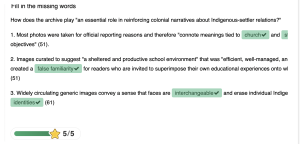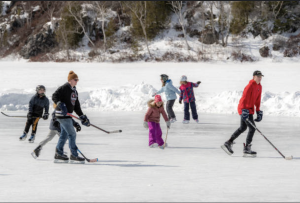4
These are difficult stories. We bear witness in this chapter to the role of sport in furthering the settler colonial projects throughout Turtle Island. Here are some supports to access in the community and from a distance:
First Peoples House of Learning Cultural Support & Counselling
Niijkiwendidaa Anishnaabekwag Services Circle (Counselling & Healing Services for Indigenous Women & their Families) – 1-800-663-2696
Nogojiwanong Friendship Centre (705) 775-0387
Peterborough Community Counselling Resource Centre: (705) 742-4258
Hope for Wellness – Indigenous help line (online chat also available) – 1-855-242-3310
LGBT Youthline: askus@youthline.ca or text (647)694-4275
National Indian Residential School Crisis Line – 1-866-925-4419
Talk4Healing (a culturally-grounded helpline for Indigenous women):1-855-5544-HEAL
Section One: History
A) The Residential School System
Exercise 1: Notebook Prompt
We are asked to honour these stories with open hearts and open minds.
Which part of the chapter stood out to you? What were your feelings as you read it? (50 words)
The chapter regarding sports and art in the TRC final report shows the real impact that sports can have on young people. The ability to succeed when given the bare minimum is certainly one aspect, but it is the impact of sport on quality of life that I feel most. There is a quote within the chapter regarding a woman who was able to play soccer and hockey and she explains that this was where she felt safe and free. That being within the sporting environment gave reprieve from the typical abuse. This again shows how the impact that spots can have for young people should not be taken for granted, and how it can improve the quality of a persons life.
There is also a comment in regards utilizing sports as a tool to simulate, which I find deplorable. While it was under funded and understaffed it was never less the only outlet provided and certainly not a traditional sport of their culture.
B) Keywords
Exercise 2: Notebook Prompt
Briefly define (point form is fine) one of the keywords in the padlet (may be one that you added yourself).
|
Sport for development ideology is a way to incorporate health promotion and increased socialization for all. This includes the ability to improve on aspects of behaviour such as emotional regulation and conflict resolution. The ability to utilize sports to share culture and promote unity across a diverse group. The ability to utilize sports to empower people and enhancing overall well being. |
C) Settler Colonialism
Exercise 3: Complete the Activities



Exercise 4: Notebook Prompt
Although we have discussed in this module how the colonial project sought to suppress Indigenous cultures, it is important to note that it also appropriates and adapts Indigenous cultures and “body movement practices” (75) as part of a larger endeavour to “make settlers Indigenous” (75).
What does this look like? (write 2 or 3 sentences)
| This would be the providing of sports that allow Indigenous ideals like being outdoors and physical movement into colonial sports. These are then utilized a source of reprieve for the Indigenous students within the residential schools. This control of their bodies along with other tactics to erase the Indigenous population works in attempts to make the colonial settlers seem as though they are in fact Indigenous to the land. |
D) The Colonial Archive

Section Two: Reconciliation
A) Reconciliation?
Exercise 6: Activity and Notebook Prompt
Visit the story called “The Skate” for an in-depth exploration of sport in the residential school system. At the bottom of the page you will see four questions to which you may respond by tweet, facebook message, or email:
How much freedom did you have to play as a child?
What values do we learn from different sports and games?
When residential staff took photos, what impression did they try to create?
Answer one of these questions (drawing on what you have learned in section one of this module or prior reading) and record it in your Notebook.
|
Photos taken at residential schools where meant to depict the success that the schools were having in assimilating the children. While sports where an avenue for children to escape the abuse it was still utilized by the schools and church to place them firmly within the colonial sporting leagues only. The photos of an abused child smiling for a picture to prove to their higher ups that they were doing a good job. |
B) Redefining Sport
B) Sport as Medicine
Exercise 7: Notebook Prompt
Make note of the many ways sport is considered medicine by the people interviewed in this video.
Sport as medicine through the interviews within the video lead to a few main points;
|
C) Sport For development
Exercise 7: Notebook Prompt
What does Waneek Horn-Miller mean when she says that the government is “trying but still approaching Indigenous sport development in a very colonial way”?
Sports being developed in a colonial way I believe that she is referring to the inability to create a strategy that will allow for Indigenous lead sport. The ability to see and distinguish those who are Indigenous from just Canadian in the Olympics, as they would be essentially competing for Canada but also their Indigenous community. The ability to provide greater access to Indigenous communities to expand within their chosen sport is also currently limited. The initiatives in place to increase colonial versions of sports within Indigenous communities and not the opposite.
Exercise 8: Padlet Prompt
Add an image or brief comment reflecting some of “binding cultural symbols that constitute Canadian hockey discourse in Canada.” Record your responses in your Notebook as well.
|
Hockey in its simplest form, kids get home from school or all weekend long. No matter how many practises or games they have played in the arena they can not wait to get back out there. The ability to bring people together and work as a team regardless of level of play. |
Section Three: Decolonization
The truth and reconciliation 94 calls to action were created to provide the Canadian government with a basis to start to work toward reconciliation with Indigenous peoples. Several of these are geared towards sports and the power that lays within them. Number 90 for instance calls to the government to ensure the stable funding, access, as well as ensure that they are developed towards Indigenous culture(CBC News, 2022). While many of these have yet to be started or continue to hang in a state of “in progress” there has thankfully been some progress here. In 2018 the Canadian government did commit to 47.5 million dollars in the initial wave to expand sport development and access in over 300 Indigenous communities. They had also committed a 9.5 million dollar annual budget ongoing(CBC News, 2022). There has been the creation of Sport for social development in Indigenous communities, the Aboriginal sport bodies, and the Aboriginal sport circle which are geared towards supporting communities to develop programs(Canada Heritage, 2025). The ability to work towards aiding Indigenous athletes to understand and meet their full potential will in fact be twofold, in that they will then be able to be recognized and modelled for future generations to come. The work that has taken place thus far is certainly a start, however does continue to require ongoing measures. The TRCs 90th call to action has been initialed but not yet completed, and will likely not be fully completed for many years to come.
References
CBC News. (2022, June). 90. ensure that national sports policies, programs and initiatives are inclusive of Aboriginal Peoples. CBCnews. https://www.cbc.ca/newsinteractives/beyond-94/ensure-that-national-sports-policies-programs-and-initiatives-are-inclusive-of-aboriginal-peoples
Canada Heritage. (2025a, February 7). Government of Canada investing $24.2 million in indigenous sport programs to empower First Nations, Inuit A… Canada.ca. https://www.canada.ca/en/canadian-heritage/news/2025/02/government-of-canada-investing-242-million-in-indigenous-sport-programs-to-empower-first-nations-inuit-and-metis-communities.html


